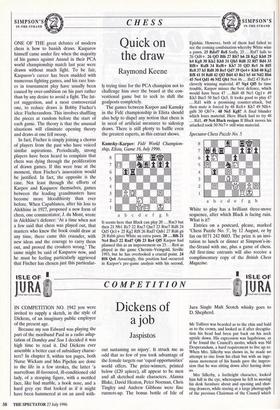SIMPSON'S writs.mArga
SIMPSON'S IN-THE-STRAND
CHESS
Quick on the draw
Raymond Keene
ONE OF THE great debates of modern chess is how to banish draws. Kasparov himself came under fire when the majority of his games against Anand in their PCA world championship match last year were drawn without much fight. To be fair, Kasparov's career has been studded with numerous fighting games, and his rare loss- es in tournament play have usually been caused by over-ambition on his part rather than by any desire to avoid a fight. The lat- est suggestion, and a most controversial one, to reduce draws is Bobby Fischer's idea: Fischerandom. This involves shuffling the pieces at random before the start of each game. The theory is that the unusual situations will eliminate opening theory and draws at one fell swoop.
In fact, Fischer is simply joining a chorus of players from the past who have voiced similar aspirations. Periodically, strong players have been heard to complain that chess was dying through the proliferation of drawn games. If this were true at the moment, then Fischer's innovation would be justified. In fact, the opposite is the case. Not least through the efforts of Karpov and Kasparov themselves, games between the leading grandmasters have become more bloodthirsty than ever before. When Capablanca, after his loss to Alekhine in 1927, proposed a new form of chess, one commentator, J. du Mont, wrote in Alekhine's defence: 'At a time when not a few said that chess was played out, that masters who knew the book could draw at any time, there came this crusader, with new ideas and the courage to carry them out, and proved the croakers wrong.' The same might be said of Kasparov now, and he must be feeling particularly aggrieved that Fischer has chosen just this particular- ly trying time for the PCA champion not to challenge him over the board at the con- ventional game but to seek to shift the goalposts completely.
The games between Karpov and Kamsky in the Fide championship in Elista should also help to dispel any notion that chess is in need of artificial measures to sidestep draws. There is still plenty to baffle even the greatest experts, as this extract shows.
Kamsky—Karpov: Fide World Champion- ship, Elista, Game 16, July 1996.
It seems here that Black can play 20 Rxc3 but then 21 Nbl Rc7 22 Rxe7 Qxc7 23 Rxe7 Rd8 24 Qd5 Qcl+ 25 Kg2 Rf8 26 Rxd7 Qxbl 27 Rd6 g6 28 Rxb6 gives White an extra pawn. 20 ...5f6 21 Nc4 Bxc3 22 Rxd7 Q115 23 Re4 Qty Karpov had planned this as an improvement on 23 ...Re6 as played in the game Chemin—Veingold, Seville 1993, but he has overlooked a crucial point. 24 Rf4 Qe6 Amazingly, this position had occurred in Karpov's pre-game analysis with his second, Epishin. However, both of them had failed to see the coming combination whereby White wins a pawn. 25 Rdxf7 Re8 Sadly, 25 ... Rxf7 fails to 26 Qd8+. 26 Q13 Bf6 27 Rb7 h6 28 Kg2 Kh8 29 h4 Kg8 30 11112 Kh8 31 Qh5 Rd8 32 Rf7 Bd4 33 1118+ RxfS 34 Rx18+ Kh7 35 Qf3 Bc5 36 RS Rc8 37 h5 Rd8 38 Re5 Qd7 39 Qe4+ Kh8 40 Kg2 Rf8 41 f4 Rd8 42 Qf3 Bd4 43 Reg b5 44 Nd2 Bb6 45 Ne4 Qdl 46 N12 Qbl Not 46 ... B2d2 47 Re8+ cleverly winning material. 47 Ng4 Qf5 In time trouble, Karpov misses the best defence, which would have been 47 ...Bd4 48 Ne5 Qgl+ 49 Kh3 BxeS 50 fxe5 Qc5. It looks good to play 47 .Rdl with a promising counter-attack, but then mate is forced by 48 Re8+ Kh7 49 Nf6+ gxf6 50 Qb7+. 48 Ne5 Kg8? A final blunder which loses material. Here Black had to try 48 ...Rdl. 49 Nc6 Black resigns If Black moves his attacked rook 50 Ne7+ still wins material.
Spectator Chess Puzzle No. 5 White to play has a brilliant three-move sequence, after which Black is facing ruin. What is it?
Entries on a postcard, please, marked 'Chess Puzzle No. 5', by 12 August, or by fax on 0171 242 0603. The prize is an invi- tation to lunch or dinner at Simpson's-in- the-Strand with me, plus a game of chess. All first-time entrants will also receive a complimentary copy of the British Chess Magazine.


























































 Previous page
Previous page